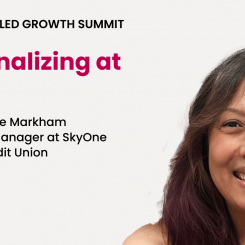For today’s top brands, marketing that reflects customers paves the way to success down the road. But while the vehicle that delivers these customers to their destination – purchasing and brand loyalty – is a well-oiled referral marketing strategy, social proof marketing acts as the wheels that carry it.
Much like buying your prized car, you wouldn’t spend time and money selecting a beautiful vehicle only to stop short of the wheels that take you where you want to go. Incorporating social proof into your referral marketing strategy works along the same lines.
So, What Is Social Proof Marketing?
Humans are hard-wired to rely on their friends, family, community, and influencers to seek out the best course of action – whether that’s finding where to eat, vetting a new purchase, or selecting a vacation spot. Social proof marketingis the practice of capturing your customers’ desire to follow the behavior of those they trust to drive them to do more, buy more, engage more.
By and large, customers trust the opinions of other customers over a brand’s sales pitch and advertising – only 15 out of every 500 people believe that a brand’s ads are accurate. This has less to do with the value of the brand or its product and more to do with the security that sticking with the crowd offers us.
By utilizing this behavior, brands can more effectively capitalize on testimonials, reviews, case studies, videos, and social media. They can use the satisfaction of their existing customer base to draw in new, connected customers.
How Do I Utilize Social Proof in My Referral Marketing Strategy?
According to a Nielsen study, approximately 90 percent of consumers trust recommendations from their friends and family compared to just 70 percent who solely trust online reviews and only 47 percent who trust traditional advertising alone.
This means that no matter how well put together your advertising campaigns are or stellar your Google review score, your customers will follow the opinions and experiences of those whose opinions they’ve already validated, from family to social media influencers.
There are several ways to capitalize on this:
- Use your existing customer base. Your advocates are loyal for a reason and have already built up an appreciation of your brand. Enable and encourage them to share these experiences with their network by offering discounts, opportunities to have their experience featured on the brand’s channels, and personalized, pre-written messaging they can quickly add to their posts.
- Take advantage of social media sharing. People love sharing what they’re buying when they feel like they’ve had a good experience or gotten a good deal. Make it easy for customers to share with their network on the channels most relevant to your audience.
- Use customer social media sharing to spread program promotion. Beyond reviews and testimonials, encourage customers to share your referral program benefits to their network too. This can also include incentives like boosted points or gift cards for your product when they share the program details.
- Find ideal new customers through current advocates. The adage that birds of a feather flock together is increasingly true in the social media age where news feeds, friends lists, and groups align your customers not only with those they trust, but also those who share valuable demographic traits such as economic standing, political beliefs, hobbies, and education level.
10 Types of Social Proof Marketing
Social proof marketingcan appear differently in everyone’s strategy, but it hinges on one key element: enabling your loyal customers and influencers to share their experiences with those who trust them.

Influencers like Brianna Madia (Hydro Flask, REI, and more) add a personal touch that resonates with their followers, promoting the brand they represent as trustworthy through the halo effect.
There are many effective ways to accomplish this, but here are the 10 easiest practices to take advantage of:
- Promoting the raw numbers of your brand. While not coming directly from the mouths of your customers, presenting consumers with metrics that support your popularity and reach (such as sales, views, and downloads) gives them the confidence that other people believe in your product.
- Leveraging testimonials and reviews. Highlight your customers’ stories, reviews, and experiences in case studies or promotional pieces, as 70% of customers report taking action after seeing online reviews and experiences. Incentivize product reviews and company testimonials with a referral program that provides giveaways and specials.
- Incentivizing advocates to refer their network. Encourage your advocates to recommend your brand to their friends and family by establishing a robust reward system for bringing in new business. Making your referral program seem exclusive – even if it isn’t – furthers the appeal of participation among current and new customers.
- Highlighting positive press. By featuring and drawing attention to positive press you’ve received – either through traditional media profiles or inclusion in prominent online resources – you show referred customers the value others see in your brand, reaffirming their choice.
- Establishing influencer marketing relationships. Seek out celebrities and expert endorsers who align with your brand and audience to add credibility to your product among your target demographics. While your audience may not know these people personally, they’re likely to trust them and their opinions because of the “halo effect,” which means that if a person has a positive online persona, products they endorse are seen in the same light.
- Featuring certifications. If your organization has completed certifications or received awards in its field, leveraging those accomplishments in digital and traditional marketing shows your customers you’re not only legitimate but recognized by your peers and community for your work.
- Creating case studies and proof of concepts from customer experiences. Use the positive experiences of your customers to create case studies showcasing the effectiveness of your service or product (think before and after shots for fitness programs). This shows referred customers the tangible results of other consumers, backing up your advertising claims.
- Fabricating FOMO among your customers. Create the illusion of urgency – and fear of missing out – by promoting specials and product offerings with deadlines or limited supply. This creates a sense of high demand among your customers and increases the likelihood that they’ll share news of their purchase if they take advantage of the offer.
- Showing social media popularity and engagement. Much like highlighting your sales and distribution numbers, sharing your social media reach – and the share count of individual posts, resources, or offers – shows customers that a wider group of people finds your brand valuable.
- Implying trust and favorability in your design. Similar to showcasing your reach and certifications, your design choices can help incentivize referred customers to join the community around your brand. This can be done subtly by choosing photos and designs that point to key calls to action – called “gazing” – such as sign-up buttons or contact us buttons.
Companies like Birchbox promote a feeling of exclusivity among their subscribers, encouraging them to share the program benefits with their personal network.

Extend Your Brand Reach With Influencer Advocates
Let your influencers create new customers. Learn how to access their followers and drive customer-led growth.
Get the GuideHow to Make Social Proof and Referral Marketing Work for You
With so many tools and strategies at your fingertips, how do you know which social proof marketing strategy will take root best with your customers? By using the knowledge gleaned from your referral marketing successes to tailor efforts to your audience.

Dropbox demonstrates how to incentivize sign-ups to their services through a referral marketing strategy that rewards existing customers for using their personal connections to bring in more business.

LUSH Cosmetics creates a sense of community around their brand – and creates product discussion while cultivating more content for their use – by creating social media “challenges” for customers to contribute to.
General tips:
- Identify the social media network your audience uses the most.
- Encourage advocates to share their experiences with friends and family through customized post language for them to share on social media.
- Offer incentives – such as when Dropbox offered an additional 500MB of storage to anyone who referred a friend and saw a 60 percent sign-up increase.
- Promote exclusivity to make your customers feel unique and valued, even if your program is open to everyone.
- Highlight top referrers on your website or social media channels by sharing their experiences.
- Include photos whenever possible; customers are substantially more likely to engage with marketing efforts when they include visual elements.
- Share information about the rewards of your program regularly with new and referred customers alike across your channels and subscription lists.
- Use user-generated content such as blogs, journals, video reviews, and photos on your social media sites; people connect best with stories.
- Once your advocates succeed in referring a friend or family member to your site, nurture that relationship. For example, HubSpot notes that brands that don’t take steps to engage subscribers can lose as much as 22.5 percent of their email list per year.
Social Proof Marketing Practices to Avoid
Despite the familiar saying, not all press is good press. It pays to be selective of what numbers and testimonials to highlight. It’s also important that brands play up the advantages and ideals of their work, rather than using negative social proof – like saying “22 percent of millennials didn’t vote in the election” vs. “Millennials are 30 percent more likely to volunteer for organizations they care about.” This can be counterproductive and instead provides an excuse for people to act in a way opposite to your goal.
Other social proof and referral marketing practices to avoid:
- Don’t highlight accounts or products with low supporting followers/metrics.
- Don’t ask for support from customers without giving something back.
- Don’t “set it and forget it” with content on social media.
- Don’t leave up spam comments or reviews on your brand’s pages.
In today’s digital world, navigating social connections and influence can be tricky. That’s where we come in. We make it easy to find and reach great influencers using first-party and social network data about your advocates to power your brand’s marketing efforts.




